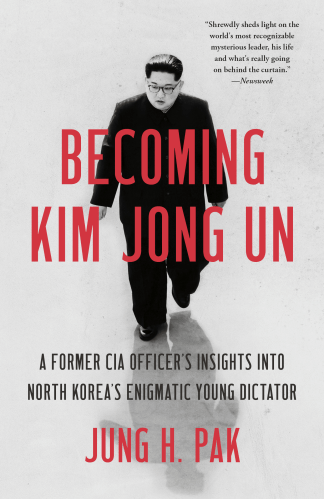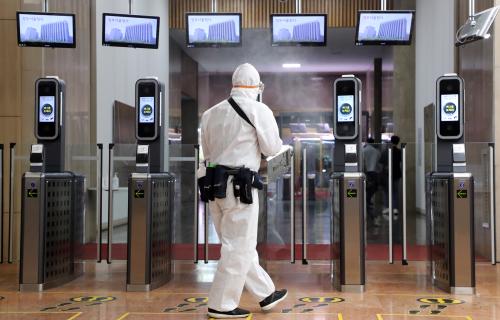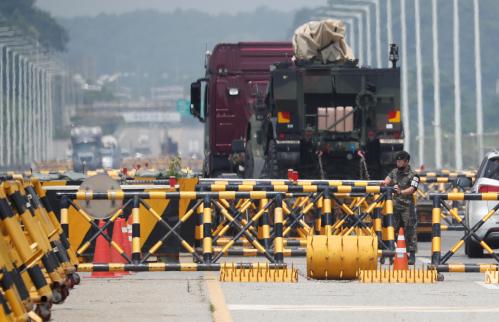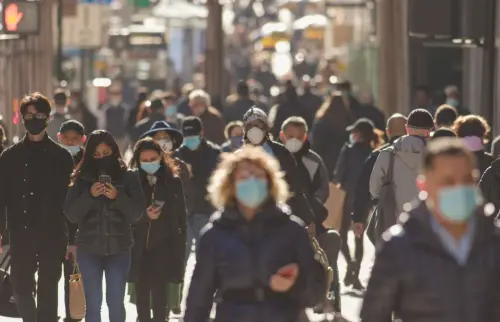The following is an excerpt from Reopening the World: How to Save Lives and Livelihoods, a new report where Brookings experts offer ideas to help policymakers protect lives and save livelihoods in the midst of the current COVID-19 pandemic.
 This year marks the 70th anniversary of the start of the Korean War. Ever since then, South Korea has prepared for confrontation with its northern enemy as the two Koreas remains technically at a war with armistice agreement, not a peace treaty. South Korea is fighting a war now, but the enemy is not the North Korean military. It is the invisible novel coronavirus. South Korea has become a subject of international media coverage for its success in handling the epidemic crisis.
This year marks the 70th anniversary of the start of the Korean War. Ever since then, South Korea has prepared for confrontation with its northern enemy as the two Koreas remains technically at a war with armistice agreement, not a peace treaty. South Korea is fighting a war now, but the enemy is not the North Korean military. It is the invisible novel coronavirus. South Korea has become a subject of international media coverage for its success in handling the epidemic crisis.
A SHAKY START
In fact, South Korea had a shaky start due to sudden spike of outbreak after the Shincheonji (New Heaven) Church of Jesus, a secretive Korean religious organization, became a source of rapid infection with tens of thousands of members. The city of Daegu, a hub for the megachurch as well as major industrial and transportation hub for the southeastern part of South Korea, became a center of battle against COVID-19 in February and March.
Yet Daegu did not become a Wuhan, a Chinese city that went through months of complete lockdown after the outbreak was reported in January; neither a New York, which plunged into a medical crisis with more than 15,000 deaths as of mid-May. There was no lockdown order of Daegu and its death toll is 181, which accounts for about 70 percent of 262 nationwide total deaths in the same period. The capital city Seoul with 10 million residents has four deaths. This is such a contrast with the U.S. death toll of over 100,000 since January 20, when both South Korea and the United States reported their first confirmed coronavirus cases. What is the South Korean secret?
LESSONS FROM SOUTH KOREA
The lessons from South Korea’s success story are as follows. First, early, efficient, and creative measures taken by the government made a difference. Second, government efforts were led by science and expert opinions. Third, notwithstanding some controversy over personal privacy, transparency in government policy combined with open information sharing all helped nationwide policy implementation with people’s trust over government efforts. As a result, South Korea has managed the epidemic without any physical lockdown in peoples’ lives. People are enjoying their normal lives with freedom of movement, job activities, and social lives.
South Korea has managed the epidemic without any physical lockdown in peoples’ lives. People are enjoying their normal lives with freedom of movement, job activities, and social lives.
Asked about South Korea’s success during her interview with ABC News, Foreign Minister Kyungwha Kang pointed to mass testing, contact tracing, and aggressive treatment (the three Ts) as the main strategies. But those measures are not new. It was from the U.S. Centers for Disease Control and Prevention that South Korean experts learned about the same measures to deal with a similar epidemic back in 2015 when MERS (Middle East Respiratory Syndrome) killed 38 out of 185 Korean patients. Since then, South Koreans took the lesson seriously, and when the second virus attack came this year, they were ready.
The real differences are speed and efficiency that South Korean authorities adopted throughout this crisis. Since the major outbreak in Daegu, the government has conducted an average of 10,000 diagnostic test per day nationwide, with creative measures like drive-through testing, which confirmed 5,000 cases out of 200,000 Shincheonji members at the early stage. Once infections are confirmed, detailed travel histories of confirmed patients and potential contacts are instantly made public through a sophisticated “contact tracing” technique using closed-circuit camera footage, credit card histories, cellular geolocation, and GPS data. Anyone who passes nearby will be alerted with an instant smartphone message.
The government also made public access to healthcare easy by covering the financial costs for related testing and treatment while reimbursing medical facilities for losses incurred from imposed quarantines. And all these measures and messages were delivered with great transparency and openness in what the government calls “a dynamic response system for open democratic societies.”
CASH RELIEF
Such efficiency was also on display with government efforts for cash relief for Korean households. Since the government announced the plan to distribute up to $800 per family of four on April 30, 80 percent of households had received the funds as of May 19, and 2.8 million Korean families got payments automatically wired to their bank accounts without even an application. The government runs a dedicated website on the program, offering quick search links that show how much families can receive and ways to apply— either online, via websites or credit card apps, or in person at banks or municipal offices. Each time the recipients use their credit card, the mobile app pings them an update of how much of the cash handout remains.
What is more, the authorities still tried to keep the balance between individual freedom and public health as much as it could. Whenever information regarding confirmed cases became available such as movement of confirmed patients, the identity of the patients was protected from the public. For this the authorities relied on an established legal infrastructure that “endows the government with highly specific levers to allocate resources and mobilize various actors in a whole-of-society effort to combat the spread of infectious disease.” When there was a recent outbreak in nightclubs in the busiest district of Seoul, the government encouraged whoever visited those places to take a virus test anonymously and free of charge. Authorities were able to conduct 60,000 tests related to the case in just 10 days with voluntary participation so that they could prevent secondary infection to family, friends, colleagues, and local communities.
The results are quite stark. Not only has South Korea had very low death and infection rates among its some 50 million population, life and the economy are quickly getting back to normal. Despite the latest nightclub outbreak, the government is easing broader restrictions by reopening national parks, public facilities, sports centers, religious gatherings, and public schools.
South Korea’s economy, largely dependent on export trade, is no exception in being affected by worldwide recession. Yet, compared to other countries, South Korea is poised to face a global downturn in a relatively better shape. The International Monetary Fund predicts South Korea’s economic growth in 2020 will be -1.2 percent, far better than -6.1 percent average for advanced economies with countries like the U.S. at -5.9, Japan at -5.2 and the eurozone at -7.5 percent.
NEW OPPORTUNITIES
At the same time, South Korea is reaping certain benefits from its success. South Korea is widely praised and recognized by the world media and other governments, promoting its global standing. While South Korean K-pop groups like BTS and movies like Parasite have led the “Korean-wave” in the U.S. and the world, now, K-health is another contender for the K-wave phenomenon, providing South Korean companies with unique business opportunities. Seegene, one of the major vendors for a virus test kit, was able to secure emergency FDA approval for American users in March and saw its stock price go up 300 percent in the first quarter this year. Many unknown small and medium South Korean bio companies like SolGent, LabGenomics, and Kogene Biotech are having a similar boosts while more ambitious giants like Celltrion and Samsung Biologics are gearing up for leading the Korean biotech industry in the world market. Most recently, Americans are watching and enjoying the Korean Baseball League on ESPN Live. And they are finding new attractions like the “bat flip” and movie-like camera work of the Korean players while most of America’s sports events are on hold, including Major League Baseball, until July.
The crisis is creating new opportunity for South Korea’s diplomatic front as well. President Moon was invited to give an opening speech for the World Health Organization annual meeting in May while world leaders, including President Trump, are rushing to ask for South Korea’s medical gear, equipment support, and various joint collaborations. China and South Korea agreed to a special waiver for businessmen traveling without quarantine measures as President Xi praised the two countries’ close cooperation in the epidemic. Meanwhile, Japanese media is urging its government to lift the export ban imposed last summer over history disputes while asking Seoul to provide medical support for Japan’s struggle with the pandemic.
And the pandemic crisis could provide a new opportunity for inter-Korean dialogue as well. North Korea has claimed it is free from the pandemic after the country swiftly declared a travel ban with China as early as January. Still some experts argue that there might be hidden cases of coronavirus, pointing to the possibility of Kim Jong-un putting himself in quarantine, given his recent disappearance from public view in April and early May. Back in March, President Moon offered to help the North’s prevention efforts. Later Kim Jong-un sent a letter expressing his best wishes for South Korea’s pandemic situation. And the coronavirus diplomacy was joined by Mr. Trump who sent a personal letter to Kim expressing his willingness to help with “anti-epidemic work.” It would be an interesting twist if the coronavirus gave a new life to U.S.-North Korea dialogue.
>While many countries and U.S. states postponed their own elections, South Korea managed to have a five-year term national general election in mid-April, with the highest turnout—66 percent—in modern history. Voters rewarded President Moon with the biggest win for the governing party, and he is enjoying over a 70 percent job approval rating, the highest ever for a single five-term presidency entering its fourth year in office.
Most of all, South Korea is better prepared for the next waves or shock from the virus. As Foreign Minister Kang told an ABC reporter, the world needs to learn to live with the coronavirus as there will be no going back to life before COVID-19.






Commentary
Reopening the World: How to deal with an invisible enemy — South Korea’s war on COVID-19
June 16, 2020